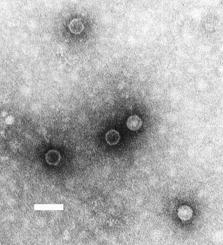Enterovirus C
A species of enterovirus associated with poliomyelitis
Overview[edit | edit source]
Enterovirus C is a species of enterovirus that includes several serotypes, most notably the three serotypes of poliovirus. These viruses are members of the family Picornaviridae, which are small, non-enveloped viruses with a single-stranded RNA genome. Enterovirus C is primarily known for its association with poliomyelitis, a disease that can cause paralysis and is preventable by vaccination.
Virology[edit | edit source]
Enterovirus C viruses are characterized by their small size and simple structure. The viral genome is composed of a single-stranded, positive-sense RNA molecule, approximately 7,500 nucleotides in length. The genome encodes a single polyprotein that is cleaved into structural and non-structural proteins. The structural proteins form the viral capsid, which is composed of four proteins: VP1, VP2, VP3, and VP4. The capsid protects the viral RNA and facilitates attachment and entry into host cells.
Transmission[edit | edit source]
Enterovirus C is transmitted primarily via the fecal-oral route. The virus can be spread through contaminated water, food, or surfaces, and can also be transmitted through respiratory droplets. Once ingested, the virus replicates in the oropharynx and intestinal tract before spreading to other tissues.
Pathogenesis[edit | edit source]
The most well-known disease associated with Enterovirus C is poliomyelitis, caused by the poliovirus serotypes. After initial replication in the gastrointestinal tract, the virus can enter the bloodstream and, in some cases, invade the central nervous system. This can lead to inflammation and destruction of motor neurons, resulting in paralysis.
Clinical Manifestations[edit | edit source]
Infection with Enterovirus C can range from asymptomatic to severe. Most infections are asymptomatic or result in mild, flu-like symptoms. However, in a small percentage of cases, the virus can cause aseptic meningitis or paralytic poliomyelitis. Paralytic poliomyelitis is characterized by acute flaccid paralysis, typically affecting the limbs.
Prevention and Control[edit | edit source]
The primary method of preventing diseases caused by Enterovirus C, particularly poliomyelitis, is through vaccination. Two types of vaccines are available: the inactivated poliovirus vaccine (IPV) and the oral poliovirus vaccine (OPV). These vaccines have been instrumental in reducing the incidence of poliomyelitis worldwide and are key components of the Global Polio Eradication Initiative.
Epidemiology[edit | edit source]
Enterovirus C is found worldwide, but the incidence of poliomyelitis has decreased dramatically due to widespread vaccination efforts. Endemic transmission of poliovirus has been interrupted in most countries, although outbreaks can still occur in areas with low vaccination coverage.
Related pages[edit | edit source]
Search WikiMD
Ad.Tired of being Overweight? Try W8MD's physician weight loss program.
Semaglutide (Ozempic / Wegovy and Tirzepatide (Mounjaro / Zepbound) available.
Advertise on WikiMD
|
WikiMD's Wellness Encyclopedia |
| Let Food Be Thy Medicine Medicine Thy Food - Hippocrates |
Translate this page: - East Asian
中文,
日本,
한국어,
South Asian
हिन्दी,
தமிழ்,
తెలుగు,
Urdu,
ಕನ್ನಡ,
Southeast Asian
Indonesian,
Vietnamese,
Thai,
မြန်မာဘာသာ,
বাংলা
European
español,
Deutsch,
français,
Greek,
português do Brasil,
polski,
română,
русский,
Nederlands,
norsk,
svenska,
suomi,
Italian
Middle Eastern & African
عربى,
Turkish,
Persian,
Hebrew,
Afrikaans,
isiZulu,
Kiswahili,
Other
Bulgarian,
Hungarian,
Czech,
Swedish,
മലയാളം,
मराठी,
ਪੰਜਾਬੀ,
ગુજરાતી,
Portuguese,
Ukrainian
Medical Disclaimer: WikiMD is not a substitute for professional medical advice. The information on WikiMD is provided as an information resource only, may be incorrect, outdated or misleading, and is not to be used or relied on for any diagnostic or treatment purposes. Please consult your health care provider before making any healthcare decisions or for guidance about a specific medical condition. WikiMD expressly disclaims responsibility, and shall have no liability, for any damages, loss, injury, or liability whatsoever suffered as a result of your reliance on the information contained in this site. By visiting this site you agree to the foregoing terms and conditions, which may from time to time be changed or supplemented by WikiMD. If you do not agree to the foregoing terms and conditions, you should not enter or use this site. See full disclaimer.
Credits:Most images are courtesy of Wikimedia commons, and templates, categories Wikipedia, licensed under CC BY SA or similar.
Contributors: Prab R. Tumpati, MD

